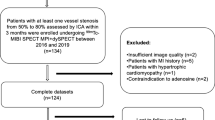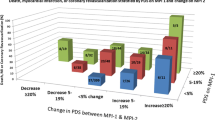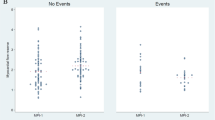Abstract
Purpose
Ischaemic myocardial dysfunction shows different time courses of functional recovery according to the pathophysiological characteristics of the dysfunction. In this study, we investigated the time course of functional recovery according to the preoperative reversibility of perfusion impairment on myocardial single-photon emission computed tomography (SPECT) after revascularisation surgery.
Methods
Forty-eight patients (42 men and 6 women; mean age 59±9 years) who underwent revascularisation surgery were included in the study. 201Tl rest/dipyridamole stress 99mTc-sestamibi gated SPECT was performed 10±8 days before (preoperative), 105±13 days after (early follow-up) and 497±66 days after (late follow-up) surgery. Using a 20-segment model, segmental perfusion and thickening were quantified with automatic software. As an indicator of the reversibility of perfusion impairment, a reversibility score (RevS) was defined as a measure of rest minus stress perfusion values. Segmental dysfunction and functional recovery were defined from quantified thickening values. Function-recovered segments were divided into early recovery and late recovery groups, and preoperative perfusion status was compared in these groups. Function-recovered segments were also re-classified into high-RevS and low-RevS groups according to the preoperative RevS, and the time courses of functional recovery were investigated in each group.
Results
A total of 502 segments were included in the analysis and 263 were finally classified as function-recovered segments. Of these, 172 were in the early recovery and 91 in the late recovery group. In terms of preoperative perfusion status, RevS was 8.9±10.8 in the early recovery group and 5.4±11.0 in the late recovery group (P=0.01). When all 502 segments were classified by RevS, no difference in the proportion of final function recovery was observed between the high-RevS and the low-RevS group (54% vs 51%). However, the proportion of early recovery was higher in the high-RevS group (73%) than in the low-RevS group (57%) (P=0.01).
Conclusion
Ischaemic dysfunctional myocardium with reversible perfusion impairment tends to recover function earlier after revascularisation surgery than myocardium with a persistent decrease in perfusion.


Similar content being viewed by others
References
Vanoverschelde JL, Depre C, Gerber BL, Borgers M, Wijns W, Robert A, et al. Time course of functional recovery after coronary artery bypass graft surgery in patients with chronic left ventricular ischemic dysfunction. Am J Cardiol 2000;85:1432–9.
Haas F, Augustin N, Holper K, Wottke M, Haehnel C, Nekolla S, et al. Time course and extent of improvement of dysfunctioning myocardium in patients with CAD and severely depressed left ventricular function after revascularization: correlation with positron emission tomographic findings. J Am Coll Cardiol 2000;36:1927–34.
Bax JJ, Visser FC, Poldermans D, Elhendy A, Cornel JH, Boersma E, et al. Time course of functional recovery of stunned and hibernating segments after revascularization. Circulation 2001;104(Suppl I):I-314–18.
Haas F, Jennen L, Heinzmann U, Augustin N, Wottke M, Schwaiger M, Lange R. Ischemically compromised myocardium displays different time-course of functional recovery: correlation with morphological alterations? Eur J Cardiothorac Surg 2001;20:290–8.
Gunning MG, Kaprielian RR, Pepper J, Pennel DJ, Sheppard MN, Severs NJ, et al. The histology of viable and hibernating myocardium in relation to imaging characteristics. J Am Coll Cardiol 2002;39:428–35.
Fallavollita JA, Perry BJ, Canty JM Jr. 18F-2-deoxyglucose deposition and regional flow in pigs with chronically dysfunctional myocardium: evidence for transmural variations in chronic hibernating myocardium. Circulation 1997;95:1900–9.
Shivalkar B, Flameng W, Szilard M, Pislaru S, Borgers M, Vanhaecke J. Repeated stunning precedes myocardial hibernation in progressive multiple coronary artery obstruction. J Am Coll Cardiol 1999;34:2126–36.
Camici PG, Rimoldi OE. Myocardial blood flow in patients with hibernating myocardium. Cardiovasc Res 2003;57:302–11.
Paeng JC, Lee DS, Cheon GJ, Kim KB, Yeo JS, Chung JK, Lee MC. Consideration of perfusion reserve in viability assessment by myocardial Tl-201 rest-redistribution SPECT: a quantitative study with dual-isotope SPECT. J Nucl Cardiol 2002;9:68–74.
Sharir T, Berman DS, Waechter PB, Areeda J, Kavanagh PB, Gerlach J, et al. Quantitative analysis of regional motion and thickening by gated myocardial perfusion SPECT: normal heterogeneity and criteria for abnormality. J Nucl Med 2001;42:1630–8.
Pryor DB, Shaw L, Harrell Jr FE, Lee KL, Hlatky MA, Mark DB, et al. Estimating the likelihood of severe coronary artery disease. Am J Med 1991;90:553–62.
Braunwald E, Rutherford JD. Reversible ischemic left ventricular dysfunction: evidence for the hibernating myocardium. J Am Coll Cardiol 1986;8:1467–70.
Rahimtoola SH. The hibernating myocardium. Am Heart J 1989;117:211–21.
Shen YT, Vatner SF. Mechanism of impaired myocardial function during progressive coronary stenosis in conscious pigs. Hibernation versus stunning? Circ Res 1995;76:479–88.
Camici PG, Wijns W, Borgers M, De Silva R, Ferrari R, Knuuti J, et al. Pathophysiological mechanisms of chronic reversible left ventricular dysfunction due to coronary disease (hibernating myocardium). Circulation 1997;96:3205–14.
Vanoverschelde JL, Wijns W, Depre C, Essamri B, Heyndrickx GR, Borgers M, et al. Mechanisms of chronic regional postischemic dysfunction in humans: new insights from the study of noninfarcted collateral-dependent myocardium. Circulation 1993;87:1513–23.
White FC, Carroll SM, Magnet A, Bloor CM. Coronary collateral development in swine after coronary artery occlusion. Circ Res 1992;71:1490–500.
Germano G, Erel J, Lewin H, Kavanagh PB, Berman DS. Automatic quantification of regional myocardial wall motion and thickening from gated technetium-99m sestamibi myocardial perfusion single-photon emission computed tomography. J Am Coll Cardiol 1997;30:1360–67.
Germano G, Kavanagh PB, Waechter P, Areeda J, Van Kriekinge S, Sharir T, et al. A new algorithm for the quantitation of myocardial perfusion SPECT. I. Technical principles and reproducibility. J Nucl Med 2000;41:712–9.
Paeng JC, Lee DS, Cheon GJ, Lee MM, Chung J-K, Lee MC. Reproducibility of an automatic quantitation of regional myocardial wall motion and systolic thickening on gated 99mTc-sestamibi myocardial SPECT. J Nucl Med 2001;42:695–700.
Sharir T, Germano G, Waechter PB, Kavanagh PB, Areeda JS, Gerlach J, Kang X, Lewin HC, Berman DS. A new algorithm for the quantitation of myocardial perfusion SPECT. II. Validation and diagnostic yield. J Nucl Med 2000;41:720–7.
Kang WJ, Lee DS, Paeng JC, Kim KB, Chung J-K, Lee MC. Prognostic value of rest 201Tl-dipyridamole stress 99mTc-sestamibi gated SPECT for predicting patient-based clinical outcomes after bypass surgery in patients with ischemic left ventricular dysfunction. J Nucl Med 2003;44:1735–40.
Lee DS, Cheon GJ, Paeng JC, Kim KB, Chung J-K, Lee MC. Criteria for definition of regional functional improvement on quantitative post-stress gated myocardial SPET after bypass surgery in patients with ischaemic cardiomyopathy. Eur J Nucl Med Mol Imaging 2002;29:1078–82.
Author information
Authors and Affiliations
Corresponding author
Rights and permissions
About this article
Cite this article
Paeng, J.C., Lee, D.S., Kang, W.J. et al. Time course of functional recovery after coronary artery bypass grafting surgery according to the preoperative reversibility of perfusion impairment on myocardial SPECT. Eur J Nucl Med Mol Imaging 32, 70–74 (2005). https://doi.org/10.1007/s00259-004-1623-9
Received:
Accepted:
Published:
Issue Date:
DOI: https://doi.org/10.1007/s00259-004-1623-9




